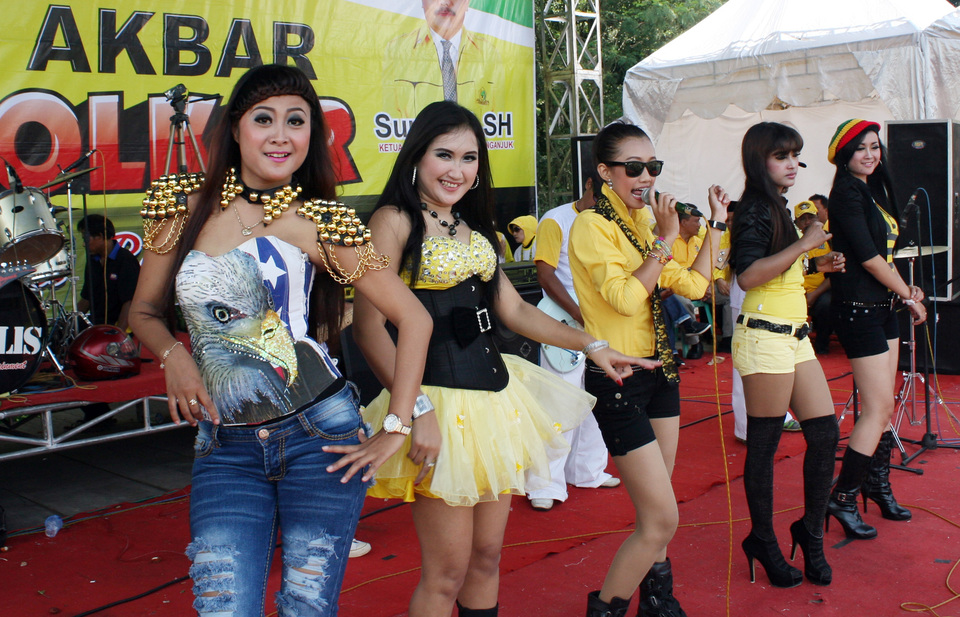From 'Drill Dance' to 'the Dribble': Dangdut Twerking Through the Ages

Jakarta. A nasal singing style and energetic gendang percussion beats may be some of the more familiar characteristics of dangdut – Indonesia's most popular form of pop music that combines Bollywood rhythms with pop melodies and, more and more these days, electronic dance music – but the genre is still best known for its "goyang," a term whose closest contemporary Western equivalent is probably "twerking."
American ethnomusicologist Jeremy Wallach wrote in his 2008 book, "Modern Noise, Fluid Genres: Popular Music in Indonesia 1997-2001" that goyang means "a slow, circular, undulating motion centered on the hips that could progress up and down the body or stay in one place."
Wallach also said that goyang is mostly done by female dangdut singers and is "responsible for much of live dangdut’s reputation for sensuality and eroticism."
Goyang is to be distinguished from joget, which is the dance that the crowd does in response to the singer's erotic provocations.
Wallach described the typical joget as: "arms frequently held up, fists tucked close to the chest, thumbs pointing upward. As one steps back and forth, the fists move up and down in a circular motion, as if they were slowly pedaling a bicycle."
While it doesn't take much skill to do the joget, goyang is often technically difficult. Female dangdut singers work on their signature move for years and often stake their reputation on it.
On the other hand, according to Wallach, "male dangdut singers are mostly judged on their singing rather than their dancing skills. Women performers are judged for their... dance moves and physical appearances."
Inul Daratista was one of the first female dangdut singers to make a signature goyang her trademark. In 2003, she became the talk of the nation with her super erotic "goyang ngebor" ("drill dance"), that involves a rapid circular movement of her hips mimicking a drill.
Inul owed her career to goyang ngebor. At the height of her popularity in mid-2000s, there was even a special-release pencil called "Pensil Inul," which was made of rubber so it can bend and twist just like Inul’s agile body. It was of course almost impossible to actually use it to write anything.
But Inul also earned a lot of conservative flak for her erotic ways. Cultural studies researcher Wiwik Sushartami, in her thesis "Representation and Beyond: Female Victims in Post-Suharto Media," recorded that in 2003, the Indonesian Ulema Council (MUI) released a fatwa (edict) declaring that Inul’s goyang ngebor was "pornographic."
At around the same time, the fading "King of Dangdut" Rhoma Irama also condemned the dance as a "threat to the nation’s morality."
Inul and her goyang legacy survived however, a small victory for freedom of expression in an increasingly conservative country.
Once she faded into semi-obscurity and early retirement to manage her popular chain of Inul Vizta karaoke bars, other female dangdut singers came along with even more extreme goyangs, earning the ire of conservatives and to the delight of dangdut fans across the nation.
As part of our celebration of National Music Day on March 9, the Jakarta Globe has compiled a list of the most popular goyang dangdut in the last two decades and categorized them according to their inspirations.
1. 'Power Tool Dances'
After Inul named her famous goyang after the drill, other female singers copycatted her move by naming their signature twerking after other power tools.
Uut Permatasari, famous for her song "Putri Panggung," ("Princess of the Stage") introduced "goyang ngecor," or "concrete casting dance." In reality, it looks very similar to Inul’s hip gyrations but Uut would periodically lift one of her legs up as she twerked.
Dewi Perssik, also a film star and a soap opera regular, became notorious for her risqué live shows where she would perform her "goyang gergaji" ("saw dance"). Her hands would move back and forth provocatively beside her hip like a saw.
2. 'Animal Dances'
Just like in hip-hop, many dangdut singers also take their inspiration from animal moves for their signature twerk.
A dangdut duo called De Mocca introduced the "goyang bebek" ("duck dance"), which involved shaking their bottoms to imitate a duck’s walk.
Zaskia Shinta popularized "goyang itik" ("duckling dance"), not too dissimilar to the duck dance. De Mocca even sued Zaskia for copying their goyang bebek but the suit was rejected by the court.
Cita Citata then came up with a bombastic name for her relatively simple move, the "goyang duyung mangap," ("a mermaid with her mouth open"). The move actually only requires swaying your arms and upper body back and forth while keeping your mouth wide open.
"Goyang pinguin" ("penguin dance") is pretty explanatory, it imitates a penguin’s walk. Walang Sangit, the dandut duo of Selvi and Eriska, familiarized the dance.
3. 'Crowd Dances'
A decade after Inul’s goyang ngebor was first unleashed to the public, there was a shift in the goyang dangdut trend. It was no longer the singers who lead it, but the crowd.
Caisar Aditya, host of the popular "Yuk Keep Smile" TV variety show, introduced "goyang Caesar" ("Caesar's dance") in 2013. He would lead the studio audience to do the move several times during the show and soon the dance became a national phenomenon.
Caisar wasn’t a singer, and his goyang Caesar was invariably accompanied by a song by popular female dangdut singer Juwita Bahar, "Buka Sitik Joss" ("Open Up and Say Ahh").
Since TV audience had taken over popularizing the dance move, for the first time in the history of dangdut it became difficult to distinguish goyang from joget.
In the same year in Klaten, Central Java, a boy named Muchtar "Temon" Setyo Wibowo rose to internet fame thanks to his unique dance moves at local dangdut gigs, where people would gather around him to copy his dance.
Temon and his followers then formed a community called Temon Holic, who comes to dangdut gigs in big groups just to dance like Temon.
Random is the perfect word to describe Temon's haphazard dance moves. Solopos reported in 2015 that Temon admitted his dances were "spontaneous." His inspiration could be anything, even banal everyday chore like washing clothes.
Honorable Mentions
Remember Annisa Bahar with her "goyang patah-patah" ("breakdance")? Basically, it’s twerking, but instead of having your bottom go up and down, you move it in a rotating manner.
Also, don’t forget "the dribble" by Duo Serigala, originally Pamela Safitri and Ovi Sovianti before Oza Kioza replaced Ovi last year.
Hips were the key asset in many previous goyang dangdut, but now, the breasts are. The "dribble" means jiggling the breasts and moving the hands up and down like a basketball player.
Duo Serigala’s record label Pelangi Records uploaded a demo video of the duo lip-syncing to their song "Abang Goda" in December 2014 while doing the dribble. Now the video has over 21 million views.
Tags: Keywords:POPULAR READS
Nissan to Make Next-Generation EV Batteries by Early 2029
Solid-state batteries are widely seen as the next step for EVs.Airlangga Set to Extend Leadership in Golkar After Election Success
Under his leadership, Golkar rose to the second position in the legislative polls and successfully made Gibran the elected vice president.Yellen Says Iran's Actions Could Cause Global 'Economic Spillovers'
Iran's missile attack on Israel early Sunday came in response to what it says was an Israeli strike on Iran's consulate in Syria.Takeaways from Prabowo's Responses to Legal Motion Contesting His Election Win
Part of the argument addresses the claim that the candidacy of Gibran Rakabuming Raka, Prabowo’s running mate, is unlawful.Prabowo Camp Cites ‘Procedural Error’ in Legal Challenge by Rival Candidates
The Constitutional Court's main task is to address alleged discrepancies in vote tallies, which neither of the plaintiffs challenged.Popular Tag
Most Popular






















